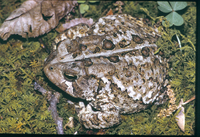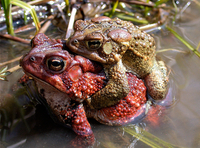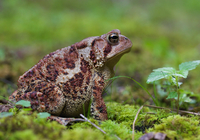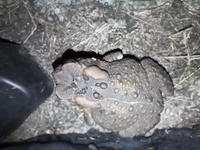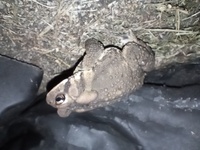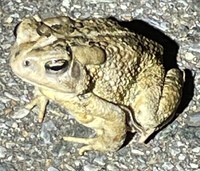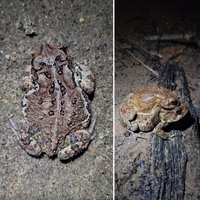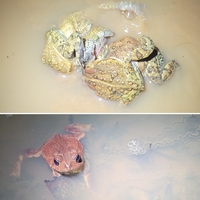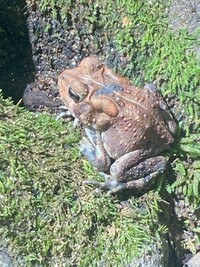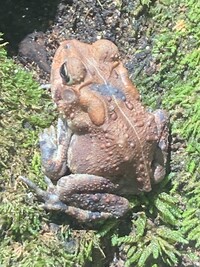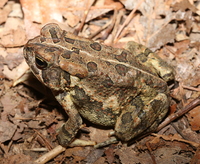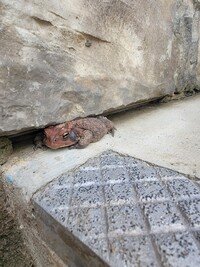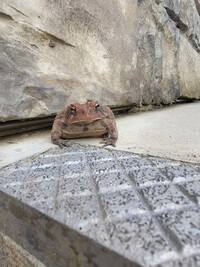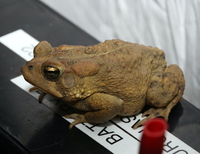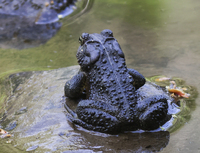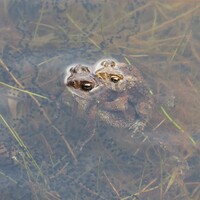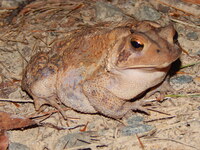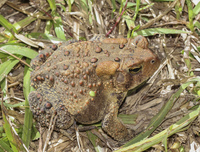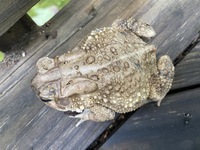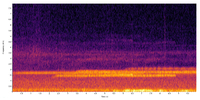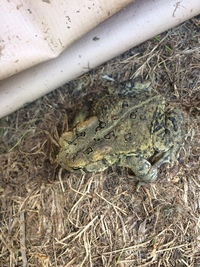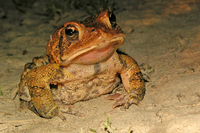Taxonomy
Class: AmphibiaOrder: AnuraFamily: BufonidaeSynonym: Bufo americanus
Taxonomic Comments: Three subspecies of the American Toad have been recognized by some authorities that reflect phenotypic variation in color pattern, spotting, the extent of ventral pigmentation, and size (Dodd 2013). These include the wide-ranging Eastern American Toad (A. a. americanus ), a smaller and more reddish Dwarf American Toad (A. a. charlesmithi ) that occurs from southwestern Indiana and southern Illinois to Arkansas, eastern Oklahoma, and northeastern Texas, and a far northern Hudson Bay Toad (A. a. copei ) that is found in the Hudson Bay region and is boldly marked and stockier than the others. Recent treatments do not recognize A. a. copei as a valid taxon, and molecular analyses do not strongly support the recognition of A. a. charlesmithi , with bootstrap values < 75% for mtDNA analyses (Masta et al. 2002). Other analyses using nuclear DNA have yet to be conducted on these forms. Here, we do not recognize subspecies and treat the American Toad (A. americanus ) as a monotypic, geographically variable species. The American Toad hybridizes with several other species of toads in areas of contact. This reflects the fact that males will often amplex heterospecific females at sites where two species are syntopic and breed at the same time of the year (Dodd 2013). In North Carolina this appears to happen on rare occasion with both Fowler's Toad and the Southern Toad (Beane et al. 2010, Dodd 2013). Species Comments: This widespread and common species has been the subject of numerous studies that are summarized by Dodd (2013).
Identification
Description: Anaxyrus americanus is a medium to large toad with most adults varying from around 50-90 mm SUL (maximum = 155 mm). The average adult size can vary substantially between regional populations, and females in local populations average larger than the males. Beane et al. (2010) reported a size range of 50-107 mm SUL for specimens from North Carolina and vicinity, and noted that populations in the mountains are larger on average than those farther east. Amplexing males that Wilbur et al. (1978) collected from a population in Chatham Co. averaged 11 mm smaller than their mates (53 versus 64 mm SUL). Vocalizations: The advertisement call is a high-pitched trill that typically last around 6–12 seconds (range = 1-19 seconds). A given male will often pause for 20-30 seconds or more before issuing another call. Call characteristics are temperature-dependent and the pulse rate is positively correlated with the water temperature near a calling male (Dodd 2013, Zweifel 1968). In addition to the advertisement call, males have a release call that consists of a series of short, vibrating chirps that signal for a male that inadvertently amplexes another male to dismount. Males may also make an amplexus call that consists of a series of clicking sounds that are emitted when clasping females (Price and Meyer 1979). Technical Reference: Dodd (2013)Online Photos: Google iNaturalist Observation Methods: The juveniles and adults are most active at night and are frequently found on roads during or following rains. Individuals sometimes feed around building lights at night, and the calling adults can be heard from long distances.
Download Video:
"MP4"
AmphibiaWeb Account
Distribution in North Carolina
Distribution Comments: This is a wide-ranging species that is restricted to eastern North America. The range in Canada extends from southern Labrador westward across Quebec through most of Ontario to southeastern Manitoba (Dodd 2013). In the US, populations have been found from the New England states westward through the Great Lakes region to the eastern Dakotas, then southward through much of the eastern US to southeastern Texas, northern and southeastern Louisiana, central and northwest Mississippi, northern Alabama, northern Georgia, and northwestern South Carolina. Populations in North Carolina are largely restricted to the western mountains, the Piedmont, and the extreme northeastern section of the Coastal Plain where an apparent geographic disjunct is present (Beane et al. 2010). We have very few records, if any, from the sandy, fire-prone sandhills, flatwoods, and savannas that once dominated the Outer Coastal Plain. Populations in the mountains are most common at lower elevations, but have been found at Mt. Mitchell and other high-elevation sites. Distribution Reference: Beane et al. (2010), Dodd (2013)County Map: Clicking on a county returns the records for the species in that county.
GBIF Global Distribution
Key Habitat Requirements
Habitat: The American Toad occurs in a variety of habitats throughout its range, but shows a general preference for open, deciduous forests. Local populations often use grasslands in the upper Midwest, and can be found in a variety of disturbed settings throughout the range so long as suitable breeding sites are nearby. Examples include conifer plantations, cut-over lands, wildlife clearings, and agricultural and urban landscapes (Dodd 2013). A. americanus is mostly restricted to the Piedmont and Blue Ridge Mountains where it is generally affiliated with deciduous forests. It occurs in both upland and bottomland hardwoods, as well as both closed canopy forests and open woodlands and edges. Populations in the Blue Ridge are mostly found in the lower valleys where breeding habitats are more prevalent, but this species has been found as high as Mt. Mitchell. While stands of hardwoods were probably the original main habitat used by this species, it is now common within semi-wooded suburban areas. In some urban areas it can be found locally where there is little or no tree cover, provided there is adequate cover and moisture at ground level and suitable breeding sites nearby. Open, sparsely vegetated areas with little cover are largely unoccupied by this species. Sites with friable soils in which to dig, abundant coarse woody debris for shelter, and mesic conditions appear to provide optimal microhabitats for the juveniles and adults (Dodd 2013). Environmental and Physiological Tolerances: The American Toad appears to be very cold tolerant, mostly because of its ability to burrow deep within friable soils. It ranges as far north as Hudson Bay and Labrador (Conant and Collins 1991) and occurs throughout the Blue Ridge Mountains in North Carolina, including occasionally at high-elevation sites. Conversely, this species may not be tolerant of extreme temperatures, being generally absent from the Atlantic and Gulf Coastal Plains. The tiny metamorphs appear to be highly vulnerable to excessive heat and dryness. Other factors that may preclude its presence in the Coastal Plain include the sensitivity of larvae to acidic waters and an inability to cope with frequent fires. The eggs and larvae are sensitive to acidic water, but local populations vary in their tolerance of acidic conditions (Dodd 2013, Freda 1986, Freda et al. 1991). Freda and McDonald (1993) surveyed ponds in Ontario and found that survivorship of larval American Toads was often reduced in ponds with a pH < 4.8. Sites with pH’s < 4.2 are often lethal for eggs. Biotic Relationships: The larvae produce skin toxins that make them unpalatable to potential predators. The degree of unpalatability varies depending on the predator and stage of development of the larvae (Brodie et al. 1978, Brodie and Formanowicz 1987), and the skin toxins rarely provide 100% protection from fishes, newts, ambystomatid larvae, odonates and other aquatic predators (Dodd 2013, Holomuzki 1995, Kats et al. 1988, Kruse and Stone 1984, Relyea 2001a, Smith et al. 1999, 2016, Voris and Bacon 1966, Walters, 1975). The larvae often breed in permanent ponds with fish, and in some cases fish may enhance the survival of larvae by preying on invertebrate predators such as dragonfly larvae (Walston and Mullin 2007). Heterodon platirhinos ), Eastern Garter Snake (Thamnophis s. sirtalis ), Northern Watersnake (Nerodia s. sipedon ), Plain-Bellied Watersnake (N. erythrogaster ), Queensnake (Regina septemvittata ) and Snapping Turtle (Chelydra serpentina ). In addition, spiders (Nyffeler and Altig 2020), skunks, raccoons, and numerous birds prey of the juveniles and adults.
Life History and Autecology
Breeding and Courtship: The males begin moving to breeding sites soon after they emerge from winter hibernation. Their long, continuous trills can be heard during the day, but singing activity generally increases in the early evening hours. The females typically arrive at the breeding sites a few days to a week after the males begin singing (AmphibiaWeb 2021). The seasonal time of arrival progressively increases from the southern and coastal portions of the range to more northern and mountainous regions. Breeding often begins in mid-January and February in Alabama and Louisiana (Dundee and Rossman 1989, Mount 1975). Breeding occurs between late-January through early April in Tennessee (Niemiller and Reynolds 2011), in March and April in West Virginia and Kentucky (Barbour 1971, Green and Pauley 1987) in mid-April to mid May in Maine (Hunter et al. 1992), and in early May to mid June in Minnesota (Oldfield and Moriarty 1994). Breeding typically occurs from late-February through March in the Piedmont of North Carolina, with populations in the mountains generally lagging behind by a few weeks depending on elevation. The peak of breeding activity usually lasts only about two weeks at a given location.Anaxyrus americanus tends to be an explosive breeder, with most mating and egg-laying in a local population occurring on only a small number of nights during the breeding season. The males may call for several weeks at a local breeding site, but females tend to arrive and mate on only a few nights. There are often only 2-4 major breeding bouts during the entire breeding season, with pauses in mating and egg-laying between bouts (Dodd 2013). Amplexus is either axillary or supra-axillary, and the pair stays together until egg laying is completed. Rival males may attempt to displace amplexed males, but are almost always unsuccessful (Howard et al. 1994). Reproductive Mode: Each female deposits two long strings of eggs in shallow water and the male fertilizes these as they protrude from the female's cloaca. The eggs are typically laid either on the bottom substrate or draped on branches, aquatic vegetation, or other support structures around the margins of wetlands. Clutch size increases with female size, with the estimated number of eggs that are laid varying from 1,700 to 20,000 per female. Thus, the biotic potential of this species is enormous. Some specific records for clutch sizes that were reported by Dodd (2013) include a mean of 4,701 (range 1,840 to 13,982) in Arkansas (Trauth et al. 1990), 3,341 in Louisiana (Dundee and Rossman 1989), 2,200–6,500 in Michigan (Brockelman 1968), 1,767–9,765 in Indiana (Howard 1988), and 3,929–15,835 eggs in Massachusetts (Miller 1909a). Hatching typically occurs within 3-7 days after the eggs are laid, but varies depending on the prevailing water temperatures and weather patterns. Aquatic Life History: The tadpoles filter-feed on detritus, algae, and other food that is suspended in the water column. They also eat filamentous algae, blue-green algae, periphyton, diatoms, soft tissues from vascular plants, crustacean eggs, carrion, and fecal material (Dodd 2013). Because of the large clutch sizes of this species and high hatching success, small ponds and other breeding sites often contain tens of thousands of hatchlings and young larvae. On sunny days the tadpoles tend to concentrate at very high densities in relatively warm water near the shoreline, then disperse and scatter into deeper waters at night. Petranka (1989a), for example, estimated that local tadpole densities along the margin of a pond in the Piedmont of North Carolina ranged from 12,412-29,725 tadpoles/m2 of pond bottom.Terrestrial Life History: The juveniles and adults often move relatively long distances from the breeding sites. They commonly have been found > 400 m from the nearest breeding site, and in some instances a kilometer or more away (Dodd 2013). Females in Maryland dispersed a minimum of 250 m and up to 1000 m from their breeding site, with 97% moving more than 400 m (Forester et al. 2006).
General Ecology
Population Ecology: Factors that regulate local populations are poorly known. Sexual competition among males for limited females may play a part, and density-dependent growth and survival during the larval stage is undoubtedly important. The population dynamics of the juvenile stage are poorly understood, but there is no evidence that the terrestrial stages are territorial. Community Ecology: Interactions of American Toad larvae with other community members have been addressed by numerous researchers using experimental communities that were established in cattle tanks, field enclosures, and laboratory aquaria (reviewed by Dodd 2013). These have involved experimentally manipulating factors such as the density and composition of competitors, the types and densities of predators, food levels, and the seasonal phenologies of competitors and predators. Larval growth rates, survival, and size at metamorphosis are typically used as response variables. These studies show that A. americanus often competes for food resources with other anuran larvae such as Scaphiopus holbrookii or Lithobates sphenocephalus that share breeding ponds, particularly when predators are absent or at low densities (e.g., Alford 1989a, 1989b, Alford and Wilbur 1985, Dodd 2013, Wilbur 1987). Predators such as the Eastern Newt can mediate the intensity and outcome of competitive interactions, and seasonal phenology can also affect the outcome of competitive interactions. The extent to which these results apply to more complex natural breeding sites is poorly resolved.
Adverse Environmental Impacts
Habitat Fragmentation: Populations of the American Toad are often found in fragmented habitats that contain both forested and agricultural or urban lands. However, studies by Rothermel (2004) and Rothermel and Semlitsch (2002) suggest that the tiny juveniles that disperse away from breeding sites often suffer high mortality when moving across open habitats such as pastures and old fields that are relatively hot and dry. Survival was inversely related to the distance from the nearest forest, which indicates the need for connectivity between breeding sites and forested habitats. Many ponds that are in open habitats and far removed from forest habitats may function as ecological traps where the adults use them as breeding sites, but few if any juveniles survival the long journey to moist, forested retreats. Effects of Pollution: Dodd (2013) provides a comprehensive summary of the known effects of pesticides and pollutants on A. americanus . Pesticides are a concern since the juveniles and adults can directly absorb water through their skin and pick up pesticides in agricultural fields. The commercial weedkiller Roundup™ is extremely toxic to toad tadpoles at ecologically relevant concentrations (Relyea, 2005a, 2005b), mostly due to the surfactant that is used in the product. The widely used fungicide Mancozeb (one ethylenebisdithiocarbamate) is also very toxic to toads at 0.08 mg/L or greater (Harris et al. 2000). Effects of Introduced Species/Induced Increases of Native Species: Devore and Maerz (2014) found that an invasive grass (Microstegium vimineum ) that is widespread in North Carolina can indirectly cause higher mortality in young toads. Areas with dense growths of Microstegeum supported relatively high densities of lycopsid spiders which preyed upon the small toads. Other studies have shown that invasive aquatic plants such as Purple Loosestrife (Lythrum salicaria ) that have high concentrations of soluble phenolics in their leaves can greatly reduce larval survival to metamorphosis (Cohen et al. 2012, Maerz et al. 2005).
Status in North Carolina
NHP State Rank: S5Global Rank: G5Environmental Threats: The greatest threats appear to be from the loss of wetlands, severe habitat fragmentation, and exposure to pesticides and pollutants. Countless thousands of toads are killed on roads annually in North Carolina, and ever increasing traffic volume adds to the problem. Status Comments: This species appears to be secure within the state. Despite the widespread loss of natural habitats, American Toads have adapted well to using constructed farm ponds, reservoirs, and water features in urban neighborhoods. Stewardship: Robust local populations are best maintained by having a cluster of breeding sites close to nearby forests. Habitat fragmentation can impact local populations since the tiny metamorphs can die when dispersing from ponds across relatively hot and dry open fields. Juvenile survival would likely be enhanced by having wooded corridors that allow dispersal from ponds that are in fields or other open habitats to nearby forests.
Photo Gallery for Anaxyrus americanus - American Toad 34 photos are available. Only the most recent 30 are shown.
Recorded by: Stephanie Willis Recorded by: Stephanie Willis Recorded by: Khaos Recorded by: Khaos Recorded by: Khaos Recorded by: Marilyn Westphal Recorded by: K. Hutson Recorded by: Andrew W. Jones Recorded by: Andrew W. Jones Recorded by: J. Mickey Recorded by: Stephanie Willis Recorded by: Stephanie Willis Recorded by: David George, Jeff Niznik Recorded by: R. Spainhour Recorded by: R. Spainhour Recorded by: David George Recorded by: Travis McLain Recorded by: John Petranka Recorded by: A. Pharr Recorded by: J. Buie Recorded by: John Petranka Recorded by: H. Quay Recorded by: Steve Hall and Savannah Hall Recorded by: Morgan Freese Recorded by: Jim Petranka Recorded by: Owen McConnell Recorded by: Owen McConnell Recorded by: Owen McConnell Recorded by: Jim Petranka and Becky Elkin Recorded by: Steve Hall
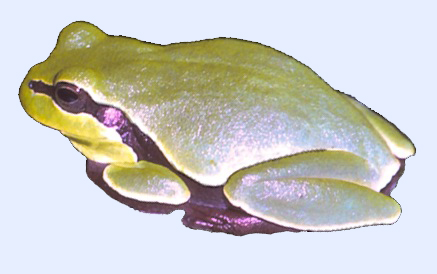
 »
»